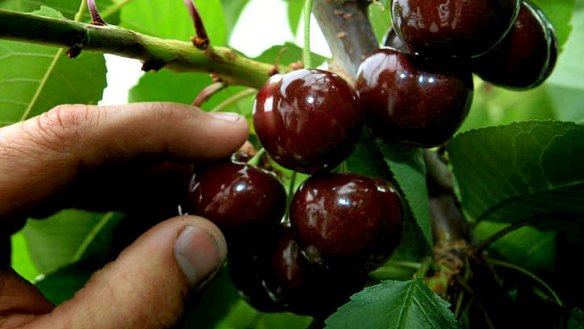The cherry challenge

It seems a long way from the Caspian Sea to the Southern Tablelands of NSW, but that's how far cherries have travelled through time.
And the climate and soil for cherries is so narrow that Young and Orange grow close to half of the country's crop. An early pioneer with an eye for fruit growing must have assessed the hillsides of Lambing Flat (now Young) because the first cherries were planted there in 1847.
It took 30 years for a commercial orchard to be established. So for public servants considering business options after decades of serving the Commonwealth, a cherry orchard might be just the thing.
Growing cherries, however, is high risk. You need well-drained hillsides and access to extra water. Both have been a challenge for me.
Cherry trees do not like heavy clay soils and quickly develop root rot if winter and spring rains lead to saturated grounds. We lost our first plantings of 30 trees after just two years, from an over wet winter.
A reasonably deep, friable, loamy soil with good drainage is pretty important.
Cherries flower well before the frost is over in Canberra so this can be another major factor.
Then we have the challenge of birds, which means no harvest at all unless the trees are wrapped in netting. Starlings are a real pest because they seem to be able to crawl underneath nets, even those draping along the ground.
Rain brings joy and heartbreak to farmers, depending on timing, intensity and volume. We suffered and Young suffered greatly in the bad drought years, with a much diminished cherry harvest. But in the past two years the heavens opened at just the wrong time. Cherry trees act like giant sponges with rain - too much and the cherries just keep expanding until they split. Then if the days stay humid, mould becomes a major problem.
One solution is to plant different varieties of cherries. There are more than 50 available, with diverse maturity dates. Cherry splitting occurs most in the last week before harvest.
So even for a backyard garden, it is worth planting cherry trees with differing maturity dates.
Canberra maturity is two weeks after Young and some varieties that grow well in hotter climates, such as Rons Seedling, do not do so well in Canberra.
There are also specific cross-pollination links for most varieties of cherries, apart from the Canadian variety Stella, which is self-pollinating. For the early-maturing varieties, I have one very early Burgsdorf and some Merchant and Supreme. My mid-season cherries are Van, Bing and Sandra Rose. Bing is the main cultivar grown in the US and it is the most reliable pre-Christmas variety for us.
For the late-season cherries, I have Lapins, Kordia and Regina, but they are yet to produce a crop.
I would be interested to hear from gardeners around Canberra about how their cherry trees have fared and produced over the past few years.
Go to this story on goodfood.com.au and add your comment there.
>> Owen Pidgeon runs the Loriendale Organic Orchard near Hall.
In the garden
■ Prepare your garden for the summer days you are away. Complete weeding around the vegetables and apply extra mulch to keep the moisture in.
■ Complete the garlic harvest, hanging up the bulbs to dry off completely before trimming and storing. Turn over the stems of onion plants a week before harvest, then harvest on a dry day before the tops are dead. Tie them into bunches and hang them up in a well-ventilated, shady place to completely dry.
■ Plant a summer crop of beans where you've harvested your garlic and onions, to provide good crop rotation and boost the soil's nitrogen content for the next crop planting.
■ If you are staying home in January, plant carrots, beetroot, sugarloaf cabbage and Asian greens and water regularly.
■ A crop of zucchinis, cucumbers, golden nugget pumpkins and sweetcorn can be achieved by mid-autumn if you plant seeds directly into garden beds now. Prepare by digging in lots of compost and adding some pelletised organic fertiliser.
■ Check your apple crop for signs of codling moth burrowing into the fruit. Simply remove infected fruit and dispose of them, to allow the clean fruit to continue growing. Inspect every two to three weeks to keep the crop healthy in a natural way. Encourage neighbours to take similar care of their fruit trees.